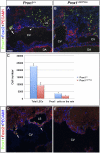Prox1 dosage controls the number of lymphatic endothelial cell progenitors and the formation of the lymphovenous valves
- PMID: 22012621
- PMCID: PMC3205588
- DOI: 10.1101/gad.16974811
Prox1 dosage controls the number of lymphatic endothelial cell progenitors and the formation of the lymphovenous valves
Abstract
Arteries, veins, and lymphatic vessels are functionally linked, and their physical interaction is tightly regulated. The lymphatic vessels communicate with the blood vessels only at the junction of the jugular and subclavian veins. Here, we characterize the embryonic lymphovenous valves controlling this vital communication and show that they are formed by the intercalation of lymphatic endothelial cells (LECs) with a subpopulation of venous endothelial cells (ECs) at the junction of the jugular and subclavian veins. We found that unlike LEC progenitors, which move out from the veins and differentiate into mature LECs, these Prox1-expressing ECs remain in the veins and do not acquire LEC features. We demonstrate that the development of this Prox1-expressing venous EC population, and therefore of lymphovenous valves, requires two functional copies of Prox1, as the valves are absent in Prox1 heterozygous mice. We show that this is due to a defect in the maintenance of Prox1 expression in venous ECs and LEC progenitors promoted by a reduction in Coup-TFII/Prox1 complex formation. This is the first report describing the molecular mechanism controlling lymphovenous communication.
Figures







Similar articles
-
The nuclear hormone receptor Coup-TFII is required for the initiation and early maintenance of Prox1 expression in lymphatic endothelial cells.Genes Dev. 2010 Apr 1;24(7):696-707. doi: 10.1101/gad.1859310. Genes Dev. 2010. PMID: 20360386 Free PMC article.
-
Prox1 physically and functionally interacts with COUP-TFII to specify lymphatic endothelial cell fate.Blood. 2009 Feb 19;113(8):1856-9. doi: 10.1182/blood-2008-03-145789. Epub 2008 Sep 24. Blood. 2009. PMID: 18815287 Free PMC article.
-
YAP and TAZ maintain PROX1 expression in the developing lymphatic and lymphovenous valves in response to VEGF-C signaling.Development. 2020 Dec 13;147(23):dev195453. doi: 10.1242/dev.195453. Development. 2020. PMID: 33060128 Free PMC article.
-
Transcriptional control of lymphatic endothelial cell type specification.Adv Anat Embryol Cell Biol. 2014;214:5-22. doi: 10.1007/978-3-7091-1646-3_2. Adv Anat Embryol Cell Biol. 2014. PMID: 24276883 Review.
-
Key molecules in lymphatic development, function, and identification.Ann Anat. 2018 Sep;219:25-34. doi: 10.1016/j.aanat.2018.05.003. Epub 2018 May 26. Ann Anat. 2018. PMID: 29842991 Review.
Cited by
-
Genetic and Molecular Determinants of Lymphatic Malformations: Potential Targets for Therapy.J Dev Biol. 2022 Feb 8;10(1):11. doi: 10.3390/jdb10010011. J Dev Biol. 2022. PMID: 35225964 Free PMC article. Review.
-
Endothelial Metabolic Control of Lymphangiogenesis.Bioessays. 2018 Jun;40(6):e1700245. doi: 10.1002/bies.201700245. Epub 2018 May 11. Bioessays. 2018. PMID: 29750374 Free PMC article. Review.
-
Segregated Foxc2, NFATc1 and Connexin expression at normal developing venous valves, and Connexin-specific differences in the valve phenotypes of Cx37, Cx43, and Cx47 knockout mice.Dev Biol. 2016 Apr 15;412(2):173-90. doi: 10.1016/j.ydbio.2016.02.033. Epub 2016 Mar 4. Dev Biol. 2016. PMID: 26953188 Free PMC article.
-
Hemodynamic regulation of perivalvular endothelial gene expression prevents deep venous thrombosis.J Clin Invest. 2019 Dec 2;129(12):5489-5500. doi: 10.1172/JCI124791. J Clin Invest. 2019. PMID: 31710307 Free PMC article.
-
Localized Prox1 Regulates Aortic Valve Endothelial Cell Diversity and Extracellular Matrix Stratification in Mice.Arterioscler Thromb Vasc Biol. 2023 Aug;43(8):1478-1493. doi: 10.1161/ATVBAHA.123.319424. Epub 2023 Jun 29. Arterioscler Thromb Vasc Biol. 2023. PMID: 37381982 Free PMC article.
References
-
- Copeland RA 2000. Enzymes: a practical introduction to structure, mechanism and data analysis. Wiley-VCH, New York
-
- Dekker RJ, van Soest S, Fontijn RD, Salamanca S, de Groot PG, VanBavel E, Pannekoek H, Horrevoets AJ 2002. Prolonged fluid shear stress induces a distinct set of endothelial cell genes, most specifically lung Kruppel-like factor (KLF2). Blood 100: 1689–1698 - PubMed
Publication types
MeSH terms
Substances
Grants and funding
LinkOut - more resources
Full Text Sources
Medical
Molecular Biology Databases
